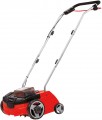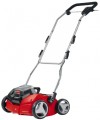Working width
The width of the strip processed by the aerator in one pass. The higher this indicator, the faster the device works, the fewer passes will have to be made to process a certain area. On the other hand,
a wide grip noticeably affects the dimensions of the entire structure and makes it difficult to work in hard-to-reach places, if not impossible. Therefore, when choosing a model in terms of working width, it is worth considering not only the overall dimensions of the site, but also its configuration and the presence of tight areas — sometimes it is preferable to sacrifice the performance of the aerator for the sake of its manoeuvrability and patency.
Shaft speed
Rotation speed of the aerator shaft in normal operation.
Manufacturers select the shaft speed in such a way that the device is guaranteed to be able to cope with the tasks for which it is designed. So in most cases, this parameter is more of a reference than practically significant. At the same time, for verticutters (see "Type"), it can also have a practical meaning: lower speed, with the same power, provides higher tractive effort and allows you to better cope with dense soils and thick rhizomes. So for such conditions, it is worth choosing a model with lower revolutions, and for a favorable environment, on the contrary, higher (high revolutions have a positive effect on performance).
Front wheel diameter
One of the parameters on which the diameter of the wheels depends is the weight of the unit: a heavy powerful aerator requires large wheels, and a light model can get by with small ones. In addition, the larger the wheels, the easier they cope with various obstacles, the better the car is suitable for difficult terrain, where you have to move through bumps, stones, etc. However, the downside of such cross-country ability is an increase in the cost of the aerator.
Rear wheel diameter
One of the parameters on which the diameter of the wheels depends is the weight of the unit: a heavy powerful aerator requires large wheels, and a light model can get by with small ones. In addition, the larger the wheels, the easier they cope with various obstacles, the better the car is suitable for difficult terrain, where you have to move through bumps, stones, etc. However, the downside of such cross-country ability is an increase in the cost of the aerator.
Noise level
The noise level produced by the aerator during operation. It is worth noting that this indicator can be indicated in different ways: some manufacturers give the maximum noise level in the characteristics, others give average values \u200b\u200bduring normal operation, etc. Anyway, this information allows you to assess the noise level of the unit and, if necessary, provide protective measures — for example, get headphones in advance.
When evaluating specific loudness values, note that the decibel used to indicate the noise level is a non-linear value. Therefore, it is easiest to evaluate specific values using comparative tables. Here is a simplified table for the range that most modern aerators fit into:
70 dB — a conversation of several people in raised tones.
75 dB — high power vacuum cleaner.
80 dB — traffic noise on a busy street.
85 dB — motorcycle engine with muffler in close proximity;
90 dB — freight car at a distance of 7 – 10 m;
95 dB — noise in the subway car on the stage;
100 dB — industrial shop.

